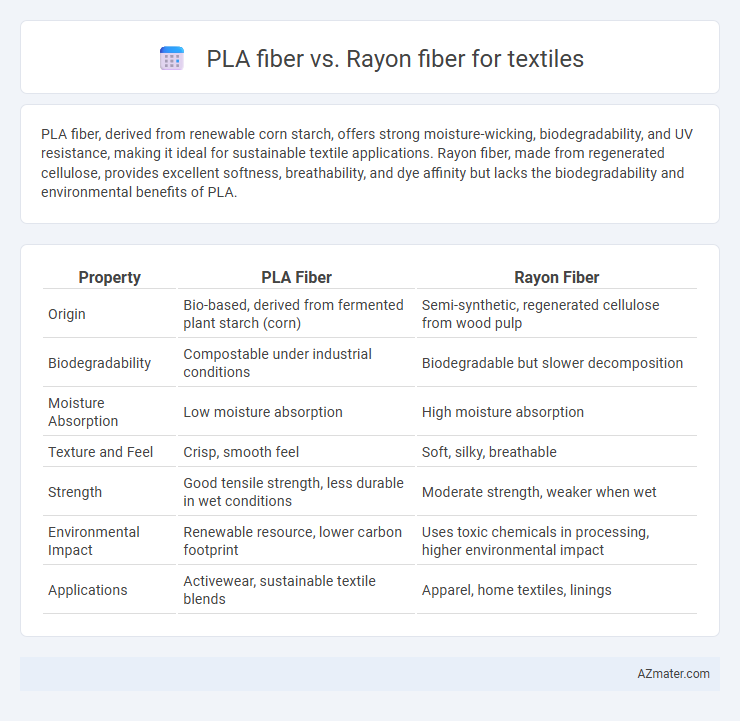PLA fiber, derived from renewable corn starch, offers strong moisture-wicking, biodegradability, and UV resistance, making it ideal for sustainable textile applications. Rayon fiber, made from regenerated cellulose, provides excellent softness, breathability, and dye affinity but lacks the biodegradability and environmental benefits of PLA.
Table of Comparison
| Property | PLA Fiber | Rayon Fiber |
|---|---|---|
| Origin | Bio-based, derived from fermented plant starch (corn) | Semi-synthetic, regenerated cellulose from wood pulp |
| Biodegradability | Compostable under industrial conditions | Biodegradable but slower decomposition |
| Moisture Absorption | Low moisture absorption | High moisture absorption |
| Texture and Feel | Crisp, smooth feel | Soft, silky, breathable |
| Strength | Good tensile strength, less durable in wet conditions | Moderate strength, weaker when wet |
| Environmental Impact | Renewable resource, lower carbon footprint | Uses toxic chemicals in processing, higher environmental impact |
| Applications | Activewear, sustainable textile blends | Apparel, home textiles, linings |
Introduction to PLA Fiber and Rayon Fiber
PLA fiber, derived from renewable resources such as corn starch or sugarcane, is a biodegradable and eco-friendly textile material offering excellent moisture-wicking properties and strong UV resistance. Rayon fiber, a semi-synthetic fiber produced from regenerated cellulose, is valued for its silk-like softness, high absorbency, and versatility in various textile applications. Both fibers serve distinct market needs, with PLA focusing on sustainability and rayon providing comfort and aesthetic appeal in clothing and home textiles.
Source and Production Process Comparison
PLA fiber is derived from renewable plant-based sources such as corn starch or sugarcane through a biotechnological fermentation process that produces polylactic acid, which is then spun into fibers. Rayon fiber originates from cellulose found primarily in wood pulp and undergoes a chemical-intensive process including steeping, shredding, and dissolving in alkali to produce viscose, which is then regenerated into fibers. The production of PLA fiber emphasizes sustainability through biopolymer synthesis with lower environmental impact, whereas rayon involves more energy-intensive chemical treatments and resource consumption from forestry.
Environmental Impact and Sustainability
PLA fiber, derived from renewable resources like corn starch, exhibits biodegradability and lower carbon emissions compared to synthetic fibers, making it a sustainable option in textiles. Rayon fiber, produced from cellulose typically sourced from wood pulp, involves chemical-intensive processes that can lead to deforestation and water pollution, raising concerns about its environmental footprint. While both fibers offer biodegradability, PLA fibers generally provide a more eco-friendly profile due to their renewable sourcing and reduced chemical usage.
Physical and Mechanical Properties
PLA fiber exhibits higher tensile strength and better moisture resistance compared to rayon fiber, making it more durable for textile applications. Rayon fiber offers superior softness and breathability but tends to have lower abrasion resistance and weaker mechanical stability under wet conditions. The crystallinity of PLA fiber contributes to its increased stiffness and dimensional stability, whereas rayon's amorphous structure results in greater flexibility but reduced mechanical resilience.
Comfort and Wearability
PLA fiber offers superior moisture-wicking properties and breathability compared to Rayon fiber, enhancing overall comfort in textile applications. Its natural biodegradability and lightweight structure contribute to better wearability, especially in activewear and casual garments. Rayon, while soft and smooth, tends to retain moisture and can feel heavier, which may reduce comfort during extended wear.
Dyeability and Color Retention
PLA fiber exhibits superior dyeability due to its crystalline structure, allowing for vibrant and uniform color uptake compared to rayon fiber. Rayon, being semi-synthetic with high moisture absorbency, tends to hold dyes well but often experiences faster color fading and less retention under prolonged exposure to light and washing. The inherent thermal and UV stability of PLA fibers contributes to enhanced color retention, making them more suitable for durable textile applications requiring long-lasting coloration.
Cost and Market Availability
PLA fiber typically costs more than rayon fiber due to its bioplastic origin and sustainable production methods, impacting textile manufacturers' pricing strategies. Rayon fiber remains more widely available globally, benefiting from established production infrastructure and extensive supply chains. Market demand for PLA fiber is growing in eco-friendly textiles, but rayon maintains dominance in cost-sensitive and mass-market applications.
Biodegradability and End-of-Life Disposal
PLA fiber, derived from renewable resources like corn starch, offers excellent biodegradability under industrial composting conditions, breaking down into natural components within months. Rayon fiber, made from regenerated cellulose, is also biodegradable but may persist longer in landfills due to less efficient degradation in anaerobic environments. Proper end-of-life disposal of PLA fiber involves industrial composting to maximize environmental benefits, whereas rayon's biodegradability depends heavily on disposal conditions, often requiring more controlled environments for complete decomposition.
Applications in the Textile Industry
PLA fiber, derived from renewable resources like corn starch, is widely used in eco-friendly textile applications such as sportswear, non-woven fabrics, and upholstery due to its biodegradability and moisture-wicking properties. Rayon fiber, a semi-synthetic cellulose fiber, excels in apparel and home textiles like dresses, blouses, and curtains because of its silk-like feel, high absorbency, and breathability. The textile industry favors PLA fiber for sustainable product lines, while rayon remains popular for its versatility and comfort in fashion and interior fabrics.
Which Fiber is Better for the Future?
PLA fiber, derived from renewable resources like corn starch, offers superior biodegradability and a lower carbon footprint compared to rayon, which is typically produced from chemically processed wood pulp. Rayon provides excellent softness and drape but relies heavily on toxic chemicals such as sulfuric acid and carbon disulfide, posing environmental and health risks. PLA fiber's sustainable production process, biodegradability, and performance properties position it as a more eco-friendly and promising textile fiber for the future.

Infographic: PLA fiber vs Rayon fiber for Textile
 azmater.com
azmater.com